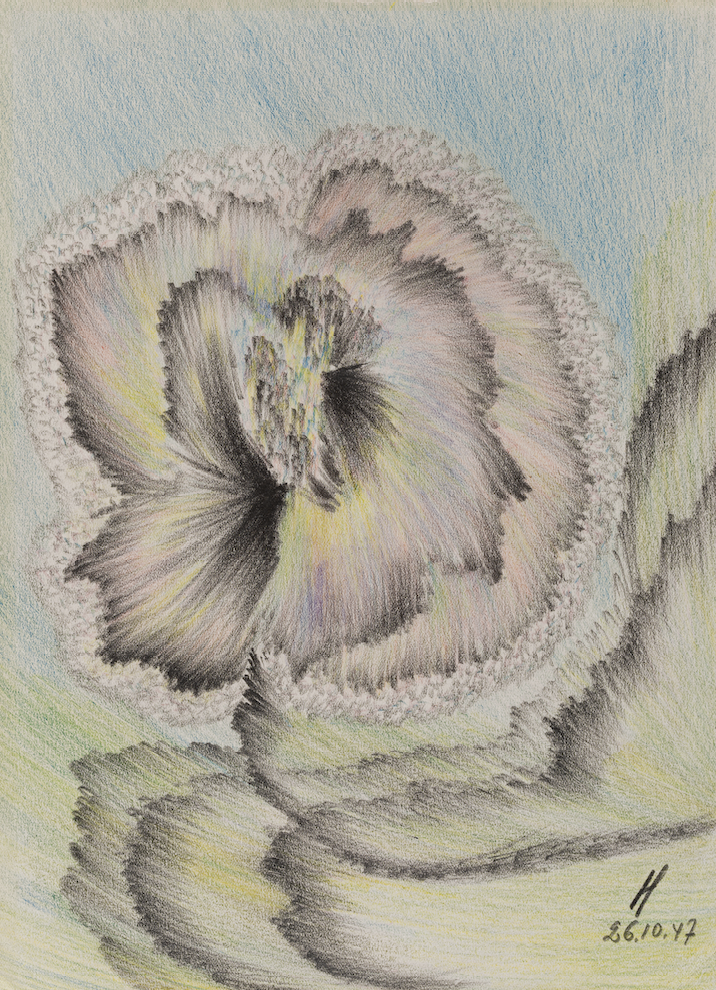Aleksandra Ionowa
Born in Lahti, Finland 1899 – Died in Lahti, Finland 1980

In 1964, a strikingly unusual art exhibition opened at the Lauttasaari Church in Helsinki. Drawings of enigmatic flowers and faces, as well as abstract compositions symbolising unseen energies and cosmic music filled each wall. The artist behind these works was Aleksandra Ionowa, though she signed each piece simply with the letter “H.” The meaning remained a mystery for decades until it was revealed recently that the “H” stood for Helena Blavatsky. Among Ionowa’s close circle, it was long believed that she was the reincarnation of Blavatsky herself, the influential founder of the Theosophical movement.
Ionowa’s creativity developed suddenly in July 1946 when she was 47 years old. Although, her spiritual path had begun much earlier when she met Theosophist Selma Mäkelä in 1926. The two became lifelong companions, immersing themselves in esoteric study and spiritual disciplines. Influenced by a broad spectrum of philosophical and spiritual movements including Theosophy, Anthroposophy, Rosicrucianism, and Freemasonry.
One person who was particularly influential on their spiritual path was Pekka Ervast, who founded the Finnish Rosicrucian Society (Ruusu-Risti) and helped establish the Finnish branch of Le Droit Humain. He emphasised spiritual experience over mere theoretical learning and believed that true knowledge involved all of the senses. Mäkelä and Ionowa embraced this philosophy fully, integrating it into a humble, nature-connected lifestyle. Living in rural Finland, they practiced daily meditation, maintained a vegetarian diet, bathed in lakes, gardened, and foraged from the forest seeking harmony with the spiritual and natural worlds.
This deeply immersive way of life became the fertile ground from which Ionowa’s art sprang. Her compositions, vivid with colour and charged with symbolic meaning, reflected the mystical realities she perceived. Ionowa rejected the label of ‘medium’, likely due to its implications of passivity. Instead, she followed the guidance of thinkers like Annie Besant, Rudolf Steiner and Ervast who argued that spiritual creation involved active will, discipline, and conscious development. Nonetheless, her work bears a striking resemblance to mediumistic art which also communicated with the spirit world through automatic drawing or heightened perception. In this broader context, Ionowa’s practice aligns with other European women spirit inspired artists, like Cecilie Marková in the Czech Republic, Josefa Tolrà in Spain and Madge Gill in England.
Ionowa’s first public show in Helsinki led to several more across Finland, and she quickly gained recognition within esoteric and artistic circles. Archival cine film held by the Ionowa Society, founded in 1969, shows her animated and joyful at these exhibitions, playing the piano, creating drawings for visitors and engaging warmly with her audience. She had no desire for commercial success, preferring to give away her works rather than sell them. This humility and generosity helped distribute her art far and wide with thousands of her drawings thought to exist across Finland. Her goal was never recognition, but spiritual expression and service with her art as a sacred offering meant to protect, heal and inspire its recipient.
Originally in Finland Ionowa was thought of as a singular mystic artist, but now it is accepted that in the broader historical context, she was part of an international, largely female movement of spiritually inspired art. Her refusal to call herself a medium doesn’t diminish the connections, but highlights the debate within spiritual traditions over the artist’s role in channelling unseen realities. She represents a rare integration of deep study, lived spirituality, and creative output. In a time of political tension, technological upheaval, and social change, Ionowa quietly cultivated a space for beauty, contemplation, and cosmic connection. Her art remains a testament to an inner world just as vivid, and perhaps more enduring, than the material one.
Today, Ionowa’s work continues to attract attention and recently found recognition with an international audience when 60 of her drawings were exhibited for the first time outside of Finland in the Creative Spirits exhibition at The College of Psychic Studies in London.
Selected Exhibitions
2025 Tranceducers ~ Great Pulteney Street Gallery, London
2025 Aleksandra Ionowa: Visions of the Spirit World and Peace ~ Gallen Kallela Museum, Espoo, Finland
2022 Creative Spirits ~ The College of Psychic Studies, London
